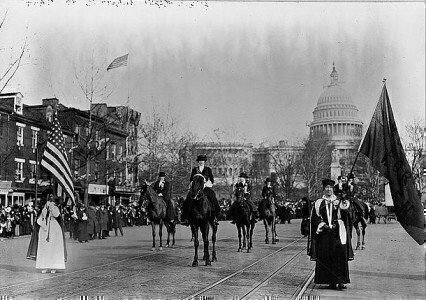Today, we celebrate the anniversary of the 19th Amendment (ratified on August 18, 1920). Here’s what you need to know:
Full Text of the 19th Amendment
 The right of citizens of the United States to vote shall not be denied or abridged by the United States or by any State on account of sex.
The right of citizens of the United States to vote shall not be denied or abridged by the United States or by any State on account of sex.
Congress shall have power to enforce this article by appropriate legislation.
Synopsis:
The Constitution has never prohibited women from voting and for many years before the adoption of this amendment women did vote in several states. The 19th amendment established a uniform rule for all states to follow in guaranteeing women this right.
Explanation:
The states ratified the 19th Amendment in 1920 after a long campaign by advocates, who achieved limited success changing state laws. The women’s suffrage movement started in the era of the Andrew Jackson administration.
In 1838, Kentucky authorized women to vote in school elections and its reforms were later copied by other states. The Seneca Falls Convention of 1848 in upstate New York played a pivotal role in bringing to public consciousness the right of women to vote. Elizabeth Cady Stanton and Lucretia Mott appealed to like-minded men and women to discuss female inequality in social and political spheres.
The first significant victory for suffrage advocates was in 1869, when the Wyoming Territory granted women voting rights on an equal basis with men and continued the practice following its admission to statehood.
In 1890, the National American Woman Suffrage Association (NAWSA) was formed from two competing suffrage groups, led first by Susan B. Anthony and then Carrie Chapman Catt. While helping to consolidate efforts and reduce rivalry within the movement, suffrage still focused on individual states to pass laws allowing women full voting rights.
But by 1914, just 10 states had joined Wyoming and other legal efforts failed. However, the push toward national Prohibition helped the women’s suffrage cause, and the two issues became linked together as prospective constitutional amendments.
In 1913, the day before Woodrow Wilson’s inauguration as President in Washington, D.C., Alice Paul and Lucy Burns organized a parade promoting votes for women. National media attention focused on the 5,000 participating women and brought the issue in front of the country.
Paul and Burns formed the Congressional Union, later the National Woman’s Party, a group whose mission was to get Congress to pass a women’s voting bill. They tried (and failed) in the 1916 elections to leverage the voting power of women in western states that already had female enfranchisement.
In 1919, the necessary votes in the Senate finally solidified. The final obstacle was getting three-fourths of the states to ratify the amendment. By mid-1920, 35 states had approved and Tennessee’s ratification ensured that the 19th Amendment was added to the Constitution, ensuring that American citizens could no longer be denied the right to vote because of their sex.







